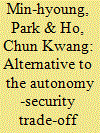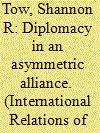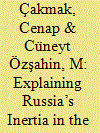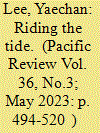| Srl | Item |
| 1 |
ID:
137226


|
|
|
|
|
| Summary/Abstract |
Most of the alliances that were formed during the Cold War period were known as a so-called “asymmetric alliance,” which means strong states provide one-sided support for the partner in a relationship at the expense of the weaker power’s autonomy. In an asymmetric alliance, a weak state gets full security support from the superpower, but in return, the weak state loses its autonomy. In this case, there is a trade-off between security and autonomy of the weaker state. This is what the Autonomy-Security Trade-off Model suggests. However, after the end of the Cold War, the weak powers, especially the developing country, have tried to increase its autonomy without any loss of its security—unlike what the Autonomy-Security Trade-Off Model argues. In this case, there may not be necessarily a trade-off between autonomy and security if a weak state decides to increase both autonomy and security simultaneously. The weak state does not usually want to lose its security, therefore it tries to find a strategy that can increase its autonomy without decreasing its security. In this sense, this paper argues that the Autonomy-Security Trade-off model has limitations to explain the above kind of national action after the Cold War. In line with this, the goal of this paper is to offer an alternative model to explain an asymmetric alliance relationship by looking at the case of the
ROK-U.S. alliance at the turn of the twenty-first century.
|
|
|
|
|
|
|
|
|
|
|
|
|
|
|
|
| 2 |
ID:
110242


|
|
|
|
|
| Publication |
2012.
|
| Summary/Abstract |
There is an assumption in international relations literature that junior allies must choose between supporting a dominant global alliance partner and engaging with a rising power. Yet, Australian policy-makers have paradoxically managed to deepen Sino-Australian relations despite their bilateral alliance with the United States. They have developed a discrete China policy on the assumption that they could persuade Washington to accept it over time. They reasoned that this outcome was more likely if Australia used diplomacy to facilitate Sino-American cooperation and to develop an Australian China policy non-prejudicial to ANZUS. This article explores how this 'diplomatic formula' supported expansion of Sino-Australian relations under the Whitlam, Hawke, and Howard Governments. It explains Australia's intra-alliance influence and paradoxical foreign policy behavior and contributes to understanding the dynamics of asymmetric alliances during power transition.
|
|
|
|
|
|
|
|
|
|
|
|
|
|
|
|
| 3 |
ID:
191765


|
|
|
|
|
| Summary/Abstract |
Russia has been conventionally portrayed in the area studies literature as a close ally of Armenia, although the latter is a subordinate rather than an equal partner. More recent scholarship has focused on Armenia’s dilemma as to whether to align itself with the liberal West or to enhance ties with its former patron. The Armenian foreign policy establishment has demonstrated in political action and discourse a marked preference for Europe’s institutions and political vision. Russia’s neutrality in the recent escalation of tension between Armenia and Azerbaijan, despite bilateral security arrangements with Armenia, showed the inherent fragilities of this asymmetric alliance. Drawing on asymmetric alliance literature, this article seeks to explain Russia’s reluctance to involve itself in the Nagorno-Karabakh dispute in favour of Armenia and identifies how Russia rewards or punishes its ally, based on its assessment of whether the ‘side payments’ attached to the alliance have been honoured.
|
|
|
|
|
|
|
|
|
|
|
|
|
|
|
|
| 4 |
ID:
192538


|
|
|
|
|
| Summary/Abstract |
This article examines how South Korea has used the ASEAN Plus security platforms to hedge between the US and China and why it has not participated in the FOIP strategy. It argues that the platforms’ neutral guise, owing to ASEAN centrality and their global norms-based agenda has allowed Korea to passively voice its alignment with the US, thereby answering to the pressure for a higher commitment from the US and clearing the political risk of linking the alignment decision to its own views. It asserts, therefore, that access to effective multilateral security platforms allows higher leverage to the weaker ally in an asymmetric alliance relationship.
|
|
|
|
|
|
|
|
|
|
|
|
|
|
|
|